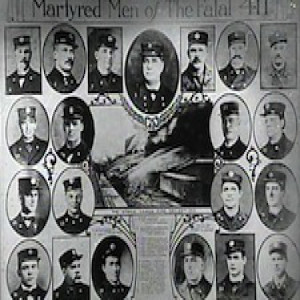
On this day in labor history, the year was 1910.
That was the day a catastrophic fire broke out in the Chicago Union Stockyards.
It claimed the lives of twenty-one firefighters and was considered the worst in Line of Duty tragedy with fatalities in fire service until September 11, 2001.
The fire broke out in Warehouse 7 of the Morris Beef Co.
By the time the fire was extinguished twenty-six hours later, fifty engine companies and seven hook and ladder companies had been called to the scene.
They arrived in horse-drawn steam engines and trucks.
Fire hydrants nearby had been shut off previously, over concerns of freezing.
This, coupled with animal fat and grease throughout the warehouse, contributed to the quick spread of the fire.
Railway cars and other buildings also surrounded the warehouse.
This made it more difficult for firefighters to access it.
Soon after they arrived, the building exploded and a wall collapsed on the firefighters.
Their comrades frantically rushed to dig them out of the scorching hot rubble with their bare hands.
But the explosion had caused a second fire in a nearby warehouse.
It would take another day before the debris had cooled enough to resume recovery efforts.
Various causes for the fire have been considered, from faulty electrical outlets to the bursting of ammonia pipes.
Nineteen widows and thirty-five orphaned children were left behind just before Christmas.
Directly behind the Union Stock Yard Gate, at the intersection of Peoria and Exchange streets, is a memorial statue, commemorating the tragic loss of the firefighters’ lives.
At the time, it was dedicated in 2004, the names of five hundred thirty firefighters were carved along its base.
More Episodes
 2024-06-09
2024-06-09
 2024-06-02
2024-06-02
 2024-06-02
2024-06-02
 2024-06-02
2024-06-02
 2024-06-02
2024-06-02
 2024-06-02
2024-06-02
 2024-05-26
2024-05-26
 2024-05-26
2024-05-26
 2024-05-26
2024-05-26
 2024-05-26
2024-05-26
 2024-05-26
2024-05-26
 2024-05-26
2024-05-26
 2024-05-19
2024-05-19
 2024-05-19
2024-05-19
 2024-05-19
2024-05-19
 2024-05-19
2024-05-19
Create your
podcast in
minutes
- Full-featured podcast site
- Unlimited storage and bandwidth
- Comprehensive podcast stats
- Distribute to Apple Podcasts, Spotify, and more
- Make money with your podcast
It is Free
- Privacy Policy
- Cookie Policy
- Terms of Use
- Consent Preferences
- Copyright © 2015-2024 Podbean.com




